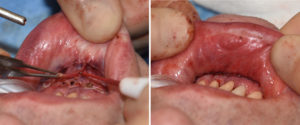Soft tissue malposition of the anterior lower face is manifest in several presentations. Chin ptosis or sagging refers to the hanging of the soft tissue chin pad off the end of the bone. It most commonly occurs from some type of chin surgery that has stretched out the soft tissue attachments. Chin implant removal is a classic example of its cause although not the only one. It can also occur from a sliding genioplasty setback, multiple intraoral chin surgeries and aging associated with alveolar bone loss.
Chin ptosis may also be associated with lower lip incompetence. As the chin pad tissue slides off of the bone it may pull down on the lower lip, creating lack of lip closure at rest and lower teeth show. This creates a dual negative perioral effect.
The most well known treatment for chin ptosis and/or lower lip incompetence is mentalis muscle resuspension. This well chronicled procedure reattaches the bony origin of the muscle higher up on the bone often at a position between the incisor tooth roots. The muscle drags up with it the overlying soft tissues of the chin pad correcting chin pad ptosis and pushing up the lower lip. While these effects of muscle manipulation often look good during surgery, they unfortunately are often not maintained as well as one would like particularly that of the lower lip.

In a shortening vestibuloplasty the mucosal lining of the depth of the vestibule is removed and a layered closure is done. This raises the height of the vestibule (shortens its depth) and helps provides support to the elevated lip.
Dr. Barry Eppley
Indianapolis, Indiana


